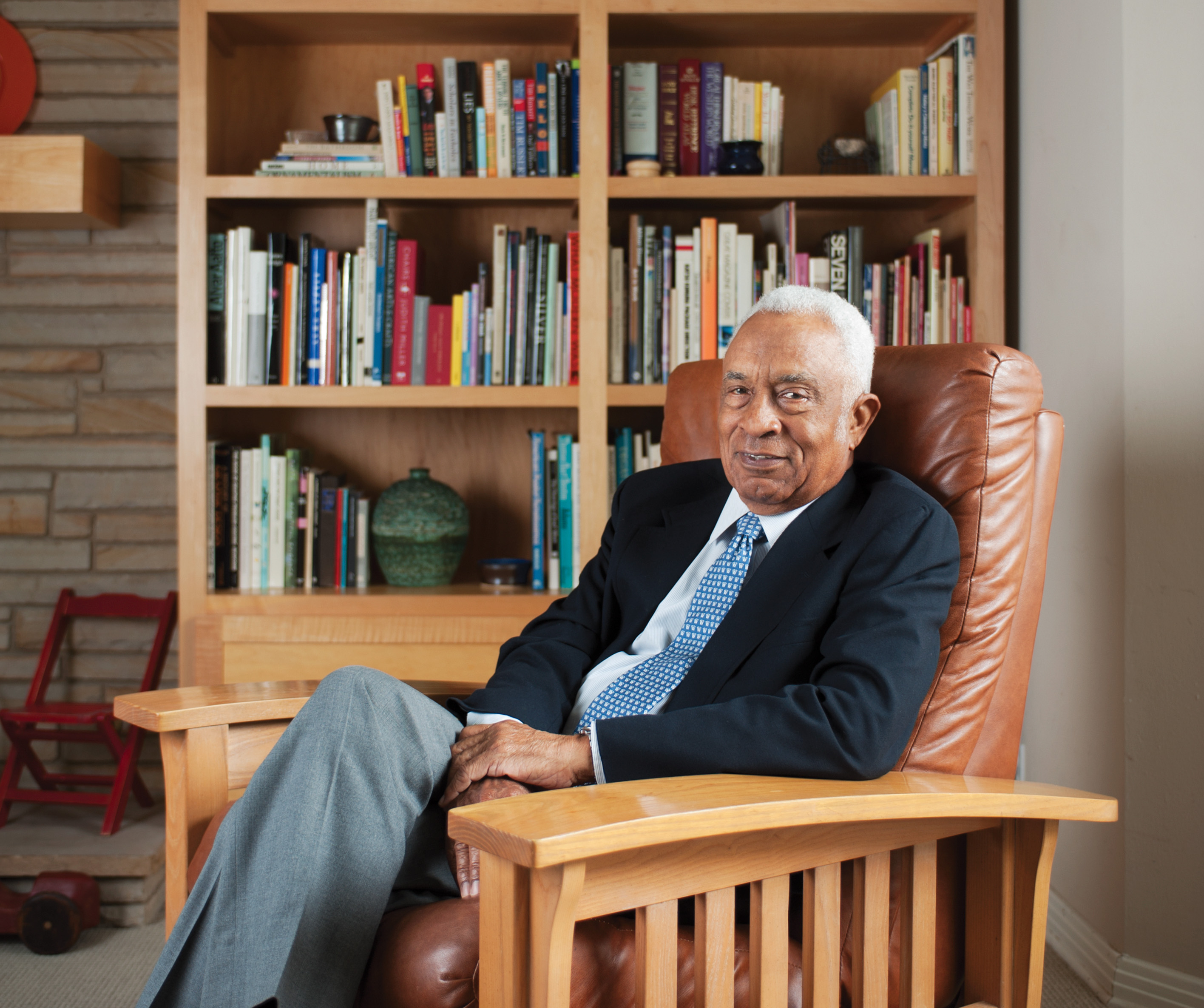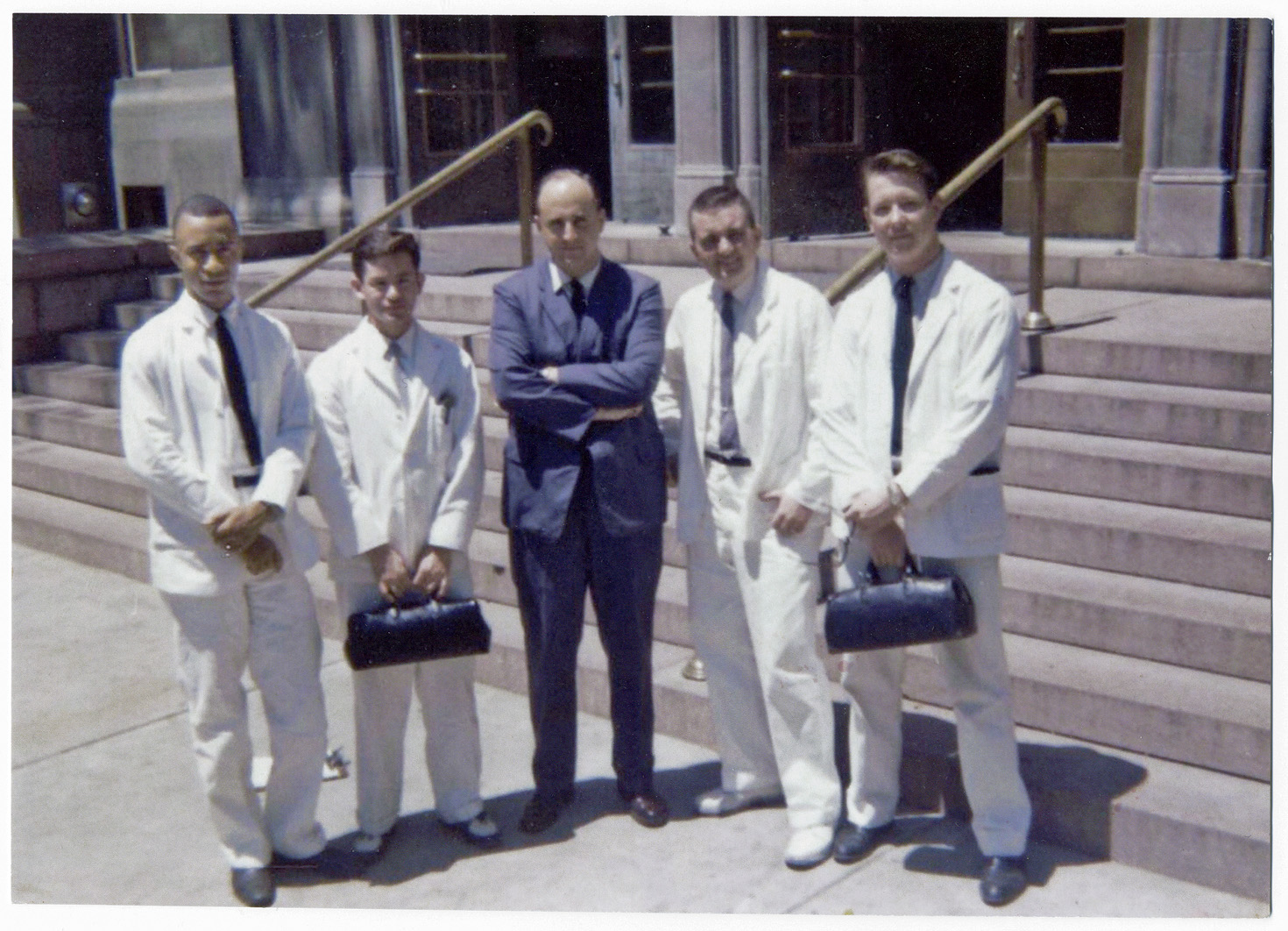
(Photo: Jim Olvera)
James L. Sweatt III, MD ’62, a trim man with cotton-white hair and a deep voice, laughs as he thinks back to his admission interview with Washington University’s School of Medicine. “I had the impression for years that it was routine for all the professors of the departments in the medical school to sit around and quiz applicants for admission,” he says. “I think it was the 25th or 50th Reunion when I found out that everyone else had been seen by one person and that was that.”
The year was 1958, and though the School of Medicine had been integrated since 1947 (several months before President Truman’s Commission on Higher Education called on states to repeal laws requiring segregation in education), only one African American had previously matriculated there, and he had dropped out.
When Harvard Medical School asked him to come in for an interview, Sweatt politely declined, saying he was going to Washington University.
Sweatt didn’t know that he could potentially become the school’s only black student and first black to graduate. No medical school had interviewed him before, so when he arrived and saw all the professors, he took it in stride.
When he found out years later that he’d gone through a more rigorous interview than his white classmates, he took that in stride too. “I was the first one through, so I guess they were just trying to make certain that I was going to use the King’s English,” he says. “They accepted me before my holiday break was over. They sent me a telegram.”
When Harvard Medical School asked him to come in for an interview, Sweatt politely declined, saying he was going to Washington University.
Growing up in segregated schools
James L. Sweatt was born in 1937 and grew up in North Dallas on Thomas Avenue, the main drag for North Dallas’ black community. His family later moved to the newly built Southern Terrace apartments in South Dallas.
“I was behind the move. My mother was a teacher in the school I was attending, and I caught hell from the other kids,” Sweatt chuckles. “She taught eighth grade, and I was scheduled to go there. I told her ‘uh-uh; I am not going to be taught by you.’”
Sweatt’s parents were divorced, and he lived with his mother while his father worked as a high school principal in Galveston, Texas.
Dallas was still a segregated city. “Whites Only” signs peppered the landscape well into the 1950s. Downtown, blacks were allowed to buy clothes in the department store, but they weren’t allowed to try them on.
When Sweatt was in elementary school, his uncle, Heman Marion Sweatt, integrated the University of Texas Law School. Heman had applied to UT but was denied entry. The university’s president, Theophilus Painter, told Heman privately that his credentials should have gained him admittance. The school cited segregation laws as the basis for denying him entry, and Heman (with the help of the NAACP) filed suit against Painter in the spring of 1946.
Sweatt v. Painter made it all the way to the U.S. Supreme Court, which decided in June 1950 that students were not given an equal quality law education in the state of Texas, and, therefore, UT would have to admit qualified black applicants. That fall, Heman registered for classes.
“I was proud,” Sweatt says. But his uncle, who died in 1982, struggled at UT. The court cases had taken a toll on Heman’s health, and his marriage broke up while he was in school. Largely ostracized, and with external pressure mounting, Heman dropped out in 1952. (Later, Heman’s heroism was recognized: The courthouse where he filed his suit was named in his honor.)
Despite his uncle’s efforts, Sweatt still went to segregated schools, first interacting with whites when he was in high school and got a job as a dishwasher at a medical facility.
After graduation, Sweatt was planning on attending Lincoln University, an all-black school in Pennsylvania. But that changed when a representative from the National Negro Scholarship Society and Fund (NNSSF) traveled through the South testing black high school students to see if they could compete in integrated East Coast schools. Sweatt and two of his friends took the test; all three passed.
“I was the only one who took advantage of it,” Sweatt says, “though I can’t say that I looked upon myself as someone doing the same thing as Uncle Heman.”
Sweatt was handed a list of colleges where the NNSSF offered scholarships, and he got into Middlebury College. Middlebury also offered a scholarship, so he decided to go, sight unseen, to the small liberal arts school in Vermont.
“The whole purpose [of the NNSSF] was to integrate the schools on the East Coast and to prove that kids from down South could come up North and compete with kids from the prep schools.”
James Sweatt III
“I felt out of place; it was all so different,” Sweatt recalls. Though there were two African-American upperclassmen, Sweatt didn’t have much interaction with them. Plus, Sweatt was behind academically. In one math course, “the professor started talking when I first walked in the room about the function of x. I’d had algebra, but this was calculus. I was lost.”
He flunked the first round of exams because he hadn’t studied. So, Sweatt buckled down and found study partners to help him.
“The whole purpose [of the NNSSF] was to integrate the schools on the East Coast and to prove that kids from down South could come up North and compete with kids from the prep schools,” Sweatt says. “Lord only knows that first year I had help from some of those kids from the prep schools.”
Studying paid off. “I have been drunk exactly one time in my life, and that was after I took the second round of exams,” Sweatt says. “I walked out of there, and I knew I had aced every one of those doggone things. And I drank 12 cans of malt liquor.”
He’d never been so sick or so elated.
Deciding to become a surgeon
Sweatt doesn’t remember who recommended Washington University to him, but he applied and was asked to interview. Since money was tight, he made St. Louis a stop on his way home for Christmas break. He didn’t stay to see the city during the visit; he was trying to get home to see a girl — his future wife, Mary Lois Hudson, whom he was escorting to a debutante ball.
When he arrived in St. Louis the following fall, he realized that he was the only black student in the medical school and that St. Louis was still a segregated city.
“It didn’t affect me much, because by that time I had learned that study is required. So most of my time was spent on the campus or in the buildings affiliated with it, which weren’t segregated,” he says.

Washington University School of Medicine integrated in spring 1947 when Lawrence Post, MD, an ophthalmology professor, discovered that he had inadvertently admitted an African American to a three-week postgraduate course. Since the university’s trustees were worried about the nation’s shortage of black physicians at the time, they announced the School of Medicine was desegregated. The School of Social Work desegregated that December, and the Graduate School of Arts & Sciences followed in May 1948.
“I think there was much goodwill in the school. More impetus was added later, certainly by the catalyst of Martin Luther King Jr., but the School of Medicine was certainly trying to become integrated.”
James Sweatt III
But the medical school was slow to admit blacks. Only two matriculated in a 10-year span.
“I think there was much goodwill in the school,” Sweatt said in a 1983 Outlook article. “More impetus was added later, certainly by the catalyst of Martin Luther King Jr., but the School of Medicine was certainly trying to become integrated.”
Sweatt remembers encountering bigotry only
twice: once, when he and his friends went to a movie, and he wasn’t let in; another time when they went to a restaurant that refused to serve him.
Though he was the only black student, Sweatt did interact with black doctors. His uncle connected him with a black surgeon in St. Louis, William Sinkler, MD, who worked at Homer G. Phillips, the black public hospital in St. Louis, where Sweatt had rounds.
“I thought they were sending me over to Homer G. Phillips because I am black,” Sweatt says. “That might have been why; I’m not certain. But it certainly helped to know that there were people around who were black and doing well.”
During this time, Sweatt decided to become a surgeon, though specializing in cardiothoracic surgery came later. He says he was inspired by Harvey Butcher, MD, who told his class not to be intimidated about going into surgery because it was mostly about mastering the techniques and being good with your hands.
“I thought, ‘Yeah, that sounds pretty good,’” Sweatt remembers, “and so I went into surgery.”
When Sweatt graduated in 1962, he was still the only black student at the school. It would be 10 years before another black student, Julian Mosley, MD ’72, matriculated.
“I think that happened because, among blacks, the Washington University medical school was perceived not only as traditionally white and expensive, but also as requiring almost impossibly impeccable credentials. Even well-qualified blacks didn’t think they would have much of a chance,” Mosley said in Outlook.
According to the former associate dean and chairman of the admissions committee, John Herweg, MD ’45, the school had again become concerned about the number of black physicians. “Back in 1967, some students, a large group of faculty and administrators began to focus on what was being perceived and discussed nationwide as a problem — the underrepresentation in medicine, and other professions, of minority groups.”
Throughout the 1970s and ’80s, the medical school began to admit more minority students, eventually becoming the top medical school in the state for graduating minority applicants.
Breaking down barriers
Sweatt continued his medical career, completing an internship at Cleveland Metropolitan General Hospital followed by two years of required service as a flight surgeon in the U.S. Air Force.
After the service, Sweatt became a resident at the University of Colorado Medical Center. As a third-year resident, Sweatt conducted research on heart valve replacement and did mitral valve surgeries in the tuberculosis unit at Colorado’s National Jewish Hospital. Sweatt enjoyed the work and decided to go into cardiothoracic surgery.
Though all his programs after Washington University were integrated, Sweatt wasn’t done breaking down barriers. He completed his residency at the University of Texas Southwestern in Dallas and then opened a private practice. In 1975, early in his career, Sweatt was the first black to be appointed to the board of directors of Dallas’ Parkland Memorial Hospital.
Sweatt shrugs off the appointment, saying that it came through a golfing buddy. He also explains away his joining the Dallas County Medical Society. “I went into it just so I’d know how best to set up my practice and how best to submit my statements for payment to the insurance company or to Medicare or Medicaid,” he says.
However, in 1995, he became the first African-American president of the Dallas County Medical Society. He went on, in 2000, to be appointed to the Texas State University System Board of Regents by then Gov. George W. Bush.
Sweatt enjoys talking about the medicine more than his accomplishments, explaining the challenges and changes in thoracic surgery well enough that even a layperson can follow along. Throughout his career, Sweatt made a point of staying up to date on best practices, completing more than 40 medical continuing education classes.
As for breaking down barriers, “I never got into it for any of that,” Sweatt says reflectively. He pauses and smiles. “But I wouldn’t change it.”